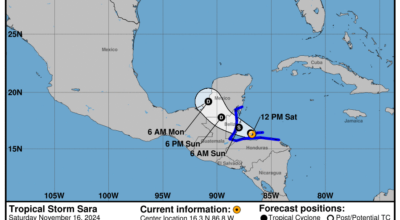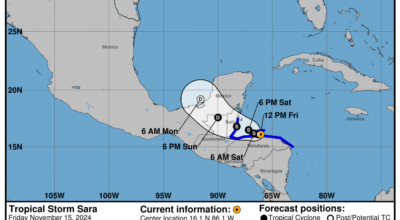Tuesday, Oct 8 update: Latest on Category 4 Hurricane Milton from the National Hurricane Center
Published 1:50 pm Tuesday, October 8, 2024

Article first published: Tuesday, Oct. 8, 2024, 4 a.m. ET
Article last updated: Tuesday, Oct. 8, 2024, 1 p.m. ET
According to the National Hurricane Center’s 1 pm Tuesday advisory, Category 4 Hurricane Milton is 125 miles northeast of Progreso Mexico and 520 miles southwest of Tampa Florida, with maximum sustained wind of 155 mph. It’s moving at 8 mph to the east-northeast.
“A turn toward the northeast with an increase in forward speed is expected to begin later today and continue through Thursday. On the forecast track, the center of Milton will move across the eastern Gulf of Mexico and approach the west-central coast of Florida through Wednesday. The center is likely to make landfall along the west-central coast of Florida on Wednesday night, and move east-northeastward across central Florida through Thursday.” forecasters noted. “While fluctuations in intensity are expected, Milton is forecast to remain an extremely dangerous hurricane through landfall in Florida.”
YESTERDAY (Monday):
Yesterday, there were a lot of changes: first, Milton changed initially into a Category 2 hurricane, a Category 3 hurricane, a Category 4 hurricane and a Category 5 hurricane but it ended up as a Category 4 hurricane with sustained winds of 155 mph.
Portions of the Florida west coast placed under a hurricane warning and a storm surge warning by forecasters.
SUMMARY OF WATCHES AND WARNINGS IN EFFECT:
A Storm Surge Warning is in effect for:
– West coast of Florida from Flamingo northward to the Suwannee River, including Charlotte Harbor and Tampa Bay
– East coast of Florida from Port Canaveral northward to the mouth of the St. Mary’s River, including the St. Johns River.
A Hurricane Warning is in effect for:
– Celestun to Rio Lagartos
– Florida west coast from Bonita Beach northward to the mouth of the Suwannee River, including Tampa Bay
– Florida east coast from the Indian River/St. Lucie County Line northward to Ponte Vedra Beach
A Storm Surge Watch is in effect for:
– South of Port Canaveral to Sebastian Inlet
– Mouth of the St. Mary’s River to Edisto Beach
A Hurricane Watch is in effect for:
– Rio Lagartos to Cabo Catoche
– Dry Tortugas
– Lake Okeechobee
– Florida west coast from Chokoloskee to south of Bonita Beach
– Florida east coast north of Ponte Vedra Beach to the mouth of the St. Mary’s River
A Tropical Storm Warning is in effect for:
– Rio Lagartos to Cancun
– All of the Florida Keys, including Dry Tortugas and Florida Bay
– Lake Okeechobee
– Florida west coast from Flamingo to south of Bonita Beach
– Florida west coast from north of the mouth of the Suwanee River to Indian Pass
– Florida east coast south of the Indian River/St. Lucie County Line to Flamingo
– Florida east coast north of Ponte Vedra Beach to the mouth of the St. Mary’s River
A Tropical Storm Watch is in effect for:
– Coast of Georgia and South Carolina from north of the mouth of the St. Marys River to South Santee River, South Carolina
– Extreme northwestern Bahamas, including Grand Bahama Island, the Abacos, and Bimini.
A Storm Surge Warning means there is a danger of life-threatening inundation, from rising water moving inland from the coastline, during the next 36 hours in the indicated locations. For a depiction of areas at risk, please see the National Weather Service Storm Surge Watch/Warning Graphic, available at hurricanes.gov. This is a life-threatening situation. Persons located within these areas should take all necessary actions to protect life and property from rising water and the potential for other dangerous conditions. Promptly follow evacuation and other instructions from local officials.
A Hurricane Warning means that hurricane conditions are expected somewhere within the warning area. A warning is typically issued 36 hours before the anticipated first occurrence of tropical-storm-force winds, conditions that make outside preparations difficult or dangerous. Preparations to protect life and property should be rushed to completion.
A Tropical Storm Warning means that tropical storm conditions are expected somewhere within the warning area within 36 hours.
A Storm Surge Watch means there is a possibility of life- threatening inundation, from rising water moving inland from the coastline, in the indicated locations during the next 48 hours. For a depiction of areas at risk, please see the National Weather Service Storm Surge Watch/Warning Graphic, available at hurricanes.gov.
A Hurricane Watch means that hurricane conditions are possible within the watch area. A watch is typically issued 48 hours before the anticipated first occurrence of tropical-storm-force winds, conditions that make outside preparations difficult or dangerous.
A Tropical Storm Watch means that tropical storm conditions are possible within the watch area, generally within 48 hours.
HAZARDS AFFECTING LAND:
STORM SURGE: A storm surge will raise water levels by as much as 2 to 4 feet above ground level along the northern coast of the Yucatan Peninsula in areas of onshore winds. Near the coast, the surge will be accompanied by large and destructive waves.
The combination of a dangerous storm surge and the tide will cause normally dry areas near the coast to be flooded by rising waters moving inland from the shoreline. The water could reach the following heights above ground somewhere in the indicated areas if the peak surge occurs at the time of high tide…
Anclote River, FL to Englewood, FL…10-15 ft Tampa Bay…10-15 ft Englewood, FL to Bonita Beach, FL…6-10 ft Charlotte Harbor…6-10 ft Yankeetown, FL to Anclote River, FL…5-10 ft Bonita Beach, FL to Chokoloskee, FL…4-7 ft Suwannee River, FL to Yankeetown, FL…3-5 ft Chokoloskee, FL to Flamingo, FL…3-5 ft Port Canaveral, FL to Altamaha Sound, GA…3-5 ft
The deepest water will occur along the immediate coast near and to the south of the landfall location, where the surge will be accompanied by large and dangerous waves. Surge-related flooding depends on the relative timing of the surge and the tidal cycle, and can vary greatly over short distances.
For a complete depiction of areas at risk of storm surge inundation, please see the National Weather Service Peak Storm Surge Graphic, available at hurricanes.gov/graphics_at4.shtml? PeakSurge.
RAINFALL: Rainfall amounts of 5 to 12 inches, with localized totals up to 18 inches, are expected across central to northern portions of the Florida Peninsula through Thursday. This rainfall brings the risk of life-threatening flash and urban flooding, along with moderate to major river flooding.
Milton will also produce rainfall totals 2 to 4 inches across the Florida Keys through Thursday.
Additional rainfall amounts of 2 to 4 inches, with isolated totals around 6 inches, are expected across northern portions of the Yucatan Peninsula.
For a complete depiction of forecast rainfall associated with Hurricane Milton, please see the National Weather Service Storm Total Rainfall Graphic, available at hurricanes.gov/graphics_at4.shtml? Rainqpf and the Flash Flood Risk graphic at hurricanes.gov/graphics_at4.shtml? Ero.
WIND: Hurricane and tropical storm conditions will continue in the warning areas in Mexico today.
Hurricane conditions are expected in the hurricane warning area across Florida beginning late Wednesday through early Thursday. Tropical storm conditions are expected to begin in the warning area on the west coast of Florida Wednesday morning, spreading across the peninsula and reaching the east coast Wednesday evening.
Tropical storm conditions are possible within the watch area on the Georgia and South Carolina coasts on Thursday.
Tropical storm conditions are possible in the extreme northwestern Bahamas on Thursday.
TORNADOES: A few tornadoes are possible over central and southern Florida beginning late tonight and continuing through Wednesday night.
SURF: Swells generated by Milton are expected to continue to affect much of the Gulf Coast within the next day or two, and are likely to cause life-threatening surf and rip current conditions.
Source: National Hurricane Center





